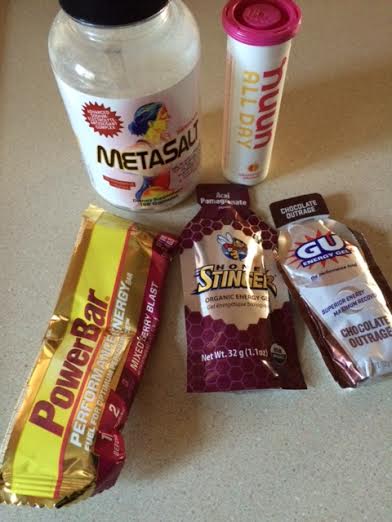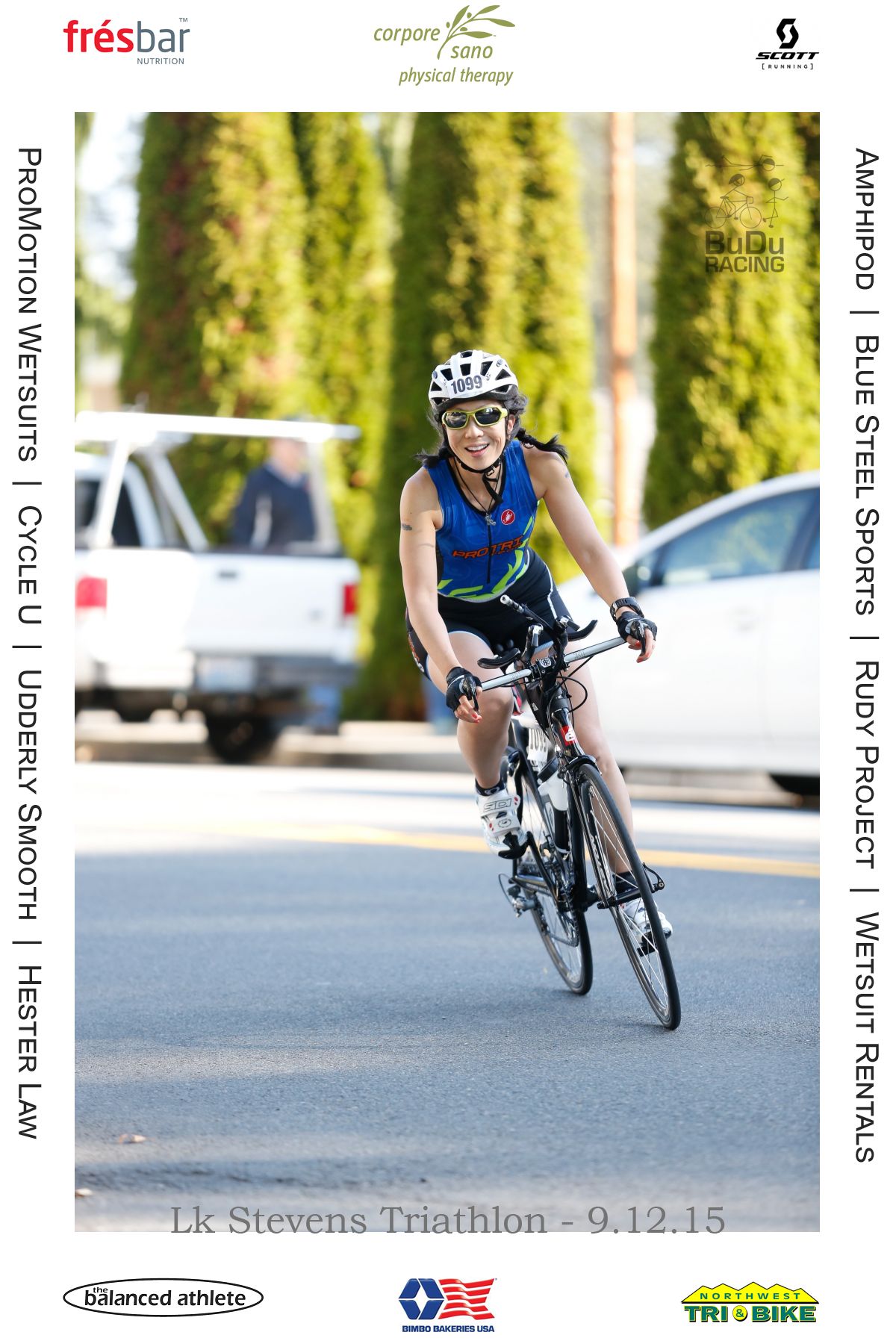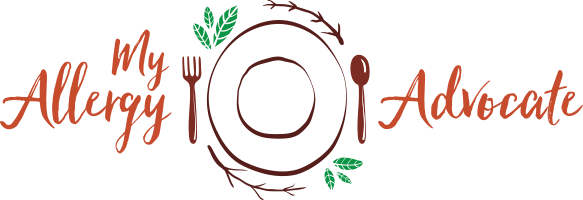
You need food to complete an Ironman. But what food? Well, that depends. Read about how the Sensible Celiac is preparing for the longest race of her life next year.
In August 2012, I had the privilege of watching my boyfriend (now husband) compete in his fourth Ironman race at Mont-Tremblant. With all the excitement in the air that day, I didn’t fail to notice the small details: the light fog on the lake, the lengthy run from the lake exit point back to transition on a red carpet; the wetsuit ‘strippers’ and the cowbells; the many, many hills of that 112 mile bike course, and the rain and dimming sunlight as the competitors panted as they ran through the chute of their second lap for the marathon course.
As one runner shuffled by, his nutrition baggie dropped out of his running belt that had been left unzipped, and several of us fans called out to him, “Hey! You dropped your food!” He looked about himself, trotted back to his baggie on the ground, and carefully stuffed it back into the belt, returning a word of thanks, and knowing that he had just dodged a nutrition gaffe, big time. Imagine running another 21 km without any food after a long day of swimming and biking!
As I think back to that moment, I am struck with what it was that he had so carefully selected for his race-day nutrition. My brain took a snapshot of it, so I remember what was there.
Want to know what was in this Ironman’s food baggie?
They Eat WHAT During An Ironman?
The triathlete’s sample Ironman food baggie contained the following:
pretzels (salt, sugar)
Red Vines licorice (sugar, corn syrup)
mini chocolate chip cookies (sugar, sugar, sugar)
And this is what my brain ends up saying: “Really? I mean, REALLY? (*insert expletive and Thug Kitchen potty mouth language*). They eat WHAT during an Ironman?!? What the whaaaat???” I told you, my brain starts sounding like I’m drinking beers with a bunch of sailors. Or pirates. It is what it is. Don’t hate.
Three years later and many triathlon and running race expos later, I am desensitized to the amount of processed foods created for endurance sports. There are new gels, bars, cookies, recovery drinks, and liquids aimed at your wallet, all with different claims on the advantages one might gain by eating or drinking their product.
Now, I’m not the food police, really. If you want to read something from the perspective of someone who does take on the role, I dunno — maybe you want to try FoodBabe (not because I agree with everything she writes, but because she’s one of the more vocal “food police” style bloggers). It’s just that I was really surprised that this triathlete had planned to eat this stuff — this “phood” — while running.
I still think there is something valuable to learn from this scenario: just because you CAN eat it doesn’t necessarily mean you SHOULD. And if there is a should, wouldn’t you want to know the WHY of that Should. And before you assume that this is my final conclusion, please hang in there, and read all the way to the end of this post.
OK, back on track. If you decide to be crazy enough to swim 2.4 miles, bike 112 miles, and then run 26.2 miles in under 17 hours, doesn’t it seem fitting to match your fuel to the awesome activity you are about to undertake, and trust that your body is the little rocket that it has been trained to be?
My image of the Ironman — this fit, fearless, strong, and mentally tough endurance athlete — was blown to bits when I saw that food baggie.. I imagined these athletes as gods and goddesses, yet gobbling and slurping garbage food to get any kind of sugar into their systems so they could go one more step forward. It doesn’t always work, you know. It’s not uncommon to see people vomiting on the side of the road when the food/garbage just won’t stay down.
This was no “one off” instance. From the magazine Triathlon Competitor, race nutrition suggestions included: bananas, jelly beans, jam sandwiches made of white bread, cereal bars, energy bars, pretzels, and chocolate bars. The article’s suggestions were meant to provide solid food options to encourage people to eat food versus race gels and gummies, which get old fast in endurance races. And if you get tired of eating something, the thinking behind solid food options is to get you eating something rather than nothing, because no eating usually is followed by bonking. And bonking is horrible. I know, because on a shorter distance training run, it happened to me, and I’m telling you, it makes you feel like you are dying.
Now as I plan for my first attempt to complete an Ironman, a large amount of my training is focused on learning how to fuel my body for the longest race day of my life. I’ve crossed out everything that I can’t eat, whether exercising or not, because of my food allergies and intolerances, to give you some idea of the challenge I face as a competitor with Celiac Disease and multiple food allergies and intolerances:
bananas, jelly beans, jam sandwiches made of white bread, cereal bars, energy bars, pretzels, and chocolate bars.
Hmm.
Convenience And Convention
Race day nutrition begins well before race day. Convenience and convention has most triathlon websites including nutrition advice along the lines of carbohydrate loading, and I am well aware how athletes will “top off” their glycogen tanks by eating a meal four hours AND two hours before the swim start. Race foods, then, become things that fit the model of convenience and convention: things you can carry in your bike jersey, in a food bento on the center bar, in a race belt during the run, and in transition bags and special needs bags, which you can access at pre-planned points.
It’s not like you can just call someone over and order a hamburger. You either planned for it, or you didn’t; you either have it in your bag, or you might get lucky and a bystander might have something for you. But that’s luck. And planning your nutrition for a race like this shouldn’t be based on luck.
The structure of Ironman distance races makes real food eaters the outliers, the rebels, the oddballs, and my food heroes. They experiment! They have little tricks and tips to employ! It’s a mind-boggling challenge to cram enough easily digestible calories for a day’s worth of racing into baggies without looking like you just strapped a food hump or a spare tire to your back or middle. Plus, I have to be careful that food isn’t resting on my low back area, as 112 miles with extra pounds of food will likely cause anyone’s back to cry by the halfway point.
So what’s the hungry and Sensible Celiac to do?
Ready? Set? Eat!
Carbo loading does not work for me, mostly because my nutritional plan is low on starchy carbohydrates by design. But you will see me eating what I call “second breakfast” from a baggie about 45 minutes before the swim start, because I discovered that my metabolism burns fat and protein mixed with a very small amount of carbohydrate.
Here’s what I’ve figured out so far are safe, solid foods to eat and drink during the bike course:
Electrolyte tablets and water
Cooked sweet potatoes and pure maple syrup (*time limit*)
Collagen (blended into the above)
Sunflower seeds and brown rice crackers
Salted seaweed
Pickles
Homemade dehydrated beef jerky
White rice, scrambled eggs, and bacon bits in a baggie (*time limit*)
“Time limit” means that these foods will either ferment or be prone to be unsafe to consume after five to six hours of exposure, so they get eaten first before all other food options.
And during the run course, any of the same above items, plus:
Honey Stinger gels (no gummies), plain honey, or maple syrup
Orange slices (last hour only)
Nuun (only in the last hour, if needed)
If you are understanding the process of discovering what will work, you will know how many countless tests I have run in my n=1 study. My point is that anyone who must eat real food will have to conduct his or her own n=1 study over multiple training periods to discover their own secret sauce. There just isn’t a one-size-fits-all nutritional plan. And there never was.
I would never claim to be a nutritionist or registered dietician, nor allow someone with a license to tell me exactly what to eat based only on convention and convenience. That’s not a very responsible way of going about this, unless I take all the factors in regarding what actually works and what doesn’t on a case-by-case analysis.
So… of course, your mileage may vary. And that triathlete with the food baggie? Perhaps nothing came of it: he ate, he biked and ran, and he finished. Maybe the next day, his plumbing was off. Maybe that night, he downed a plate of poutine, burped up some gravy, and all was well.
All I know is that there will be be no beer and poutine for me.
Is There Anything Missing?
After analyzing, counting calories, looking at my metabolic rate, and eliminating foods that cause problems, I looked at the food list above and asked, “Is there anything missing?” The answer, in my opinion, is Yes — there is something missing.
The known “rocket fuel” of endurance racing involves dosing with caffeine. There have been scholarly journal articles submitted all the way back to 1994 that connect caffeine dosing with endurance performance (just not high intensity exercise), and the international Olympic Committee has its own standards of allowable caffeine use for its competitors. You could think of caffeine as the only energy stimulating drug that the Olympics allows, and most of the wording you will see on the Internet will include phrases such as, ” legal ergogenic ingredient”. Ergogenic simply means that the ingredient enhances athletic performance and/or recovery; legal simply means that it is allowed. Neither word implies whether you should consume it. But I think the evidence is pretty compelling for trying it, as long as you are not caffeine sensitive (and if you are, stay away from caffeine).
The three most common ways triathletes ingest caffeine during a race are:
- in a gel, such as Gu or Honey Stingers w/ Caffeine
- in a pill
- in a liquid, such as a flat can of Coke.
Since I cannot have Gu, I tried the Honey Stinger energy chews with Caffeine. My tummy said, “Nope!” on Tests One, Two, and Three. When I try something three times and it fails three times, I move on.
That leaves caffeine pills and Coke.
So in the coming months, as my Computrainer rides, outdoor runs, and brick workouts lengthen in time and deepen in intensity, I’ll be testing out Saltstick’s Electrolyte tabs and Canadian Coca-Cola (free of high fructose corn syrup) to see which ones work for me and which, if any, I want to avoid.
Which brings me to my last thought on the subject: do I really want to eat and drink this stuff? Does that turn me into the same people I looked up to, the ones who were gobbling pretzels and licorice whips? Will I no longer become a goddess?
Well, I promised earlier in this post that if you hung in there and read all the way to the end of this post, I had a little more to say about whether I should trust in the training, or I should succumb to convention and eat as those who have gone before me have done to get themselves across that damn finish line and become an Ironman.
Well, durr. Isn’t more likely that the answer lies somewhere in between? Yes, trust that all the training is going to turn me into a fat-burning, efficient engine. And yes, train for and practice the nutrition for the different phases of the race, understanding that this amazing body that I have needs different fuel for different phases — that it might need pickles on the bike, and then it might just want that “rocket fuel” corn-free Coca-Cola and water on the run.
The bigger point I’m learning is this: race day food isn’t everyday food. Therefore, don’t eat it everyday. I wouldn’t want to put Coca-Cola in my body on a regular basis, and therefore, I don’t. The last time I had one was in 2012. But that is about to end. A friend has offered to bring back some Canadian, real-sugar Coca-Cola for me to start doing my tests, and I’ll be journaling the results so I can make my best selection for my race day.
And so, I am on my Ironman journey, a goddess with skinny arms that must be turned into effective paddles, legs that need strengthening, a core prone to aches and pains (and right now, really hates “dead bugs” on a Bosu ball), a mind that does not bend easily in the dark places, and a tummy that revolts with the hidden ingredients in the words, “natural flavors added.”
Eat well, my fellow food allergic and sensitive minions. And then, when it’s time to soar, choose wisely. Let’s show the world what we gots, because we gots a lots!
Your Calls To Action
1. Do you have a food or hydration tip that works for the food sensitive, food allergic world? Share it here!
2. Do you want to try some homemade “race food”, but you don’t know where to start? Contact me here in a comment, or email me, and I’ll send you an email with some questions about what you can eat, and I’ll help you consider your options (remember, I’m not a nutritionist, but I am well-read on the subject of food and endurance sports).
3. Got a favorite food hero on the Internet that you would like to give a compliment to? Please do it, and tell them I said, “Thank you!” for their work in sharing the love.
4. Ready to try a 7 Day Cook At Home/Eat In Challenge? Check it out, and join my ‘Masticating Minions’ (OK, I don’t have an official name for the group yet!). I created a special badge for my 7-Day Challenge finishers! I’ve eaten food cooked only from a home kitchen for weeks at a time, and yes, I just finished yet another seven-day round during Thanksgiving Day week (my friend’s dinner was cooked all at home, no processed foods, all AIP and Celiac safe)! Woo hoo!
Join us, and let’s make food fun again.





